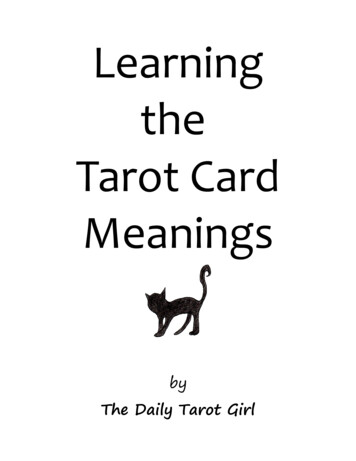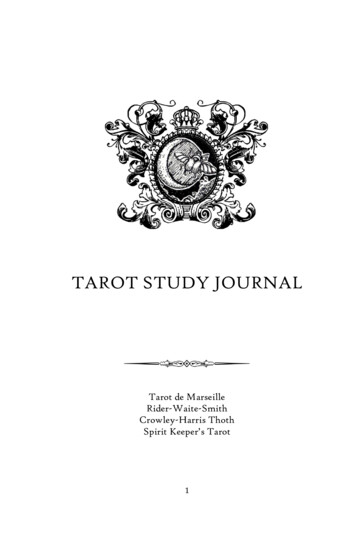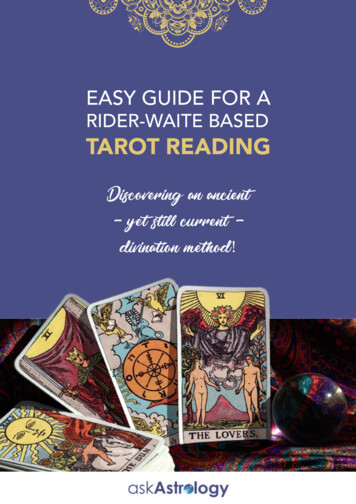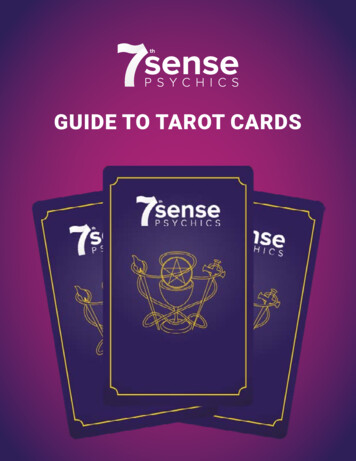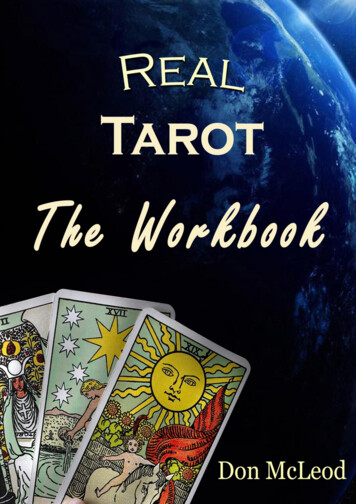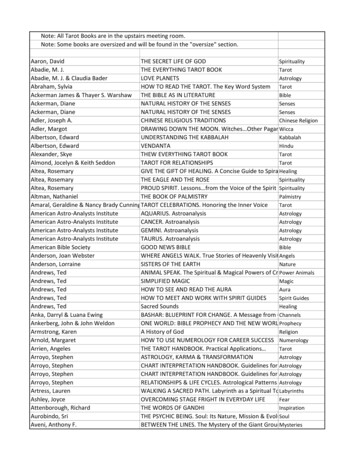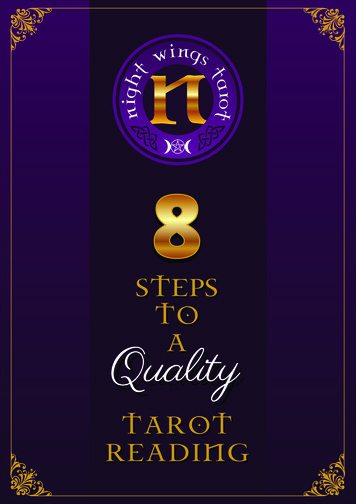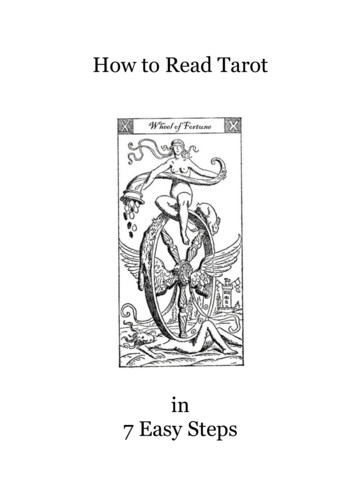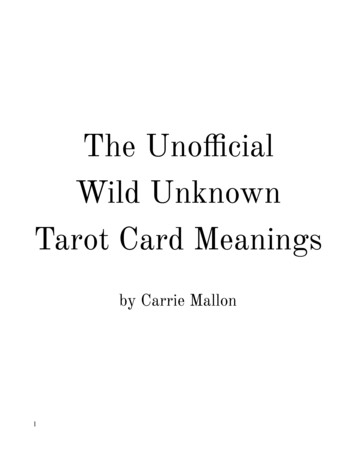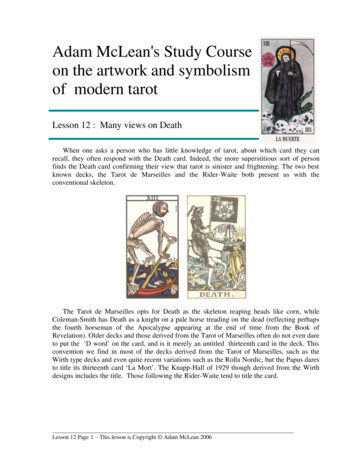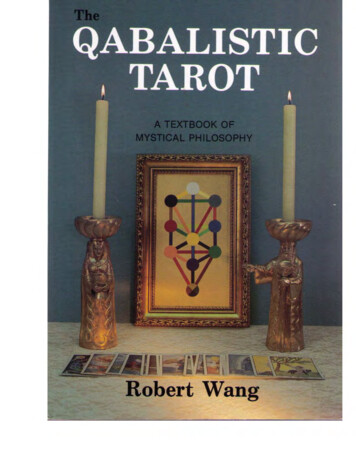
Transcription
A TAROT HISTORY TIMELINEBy Dame GabbyThe modern tarot is a deck of 78 cards consisting of 2 types of cards: the 22 cards of the "Major Arcana" or "Trumps which arenamed (such as the Lovers, Death and Judgement), and the "Minor Arcana" or "suit cards" (four suits of fourteen cards, eachcomprised of cards numbered from one to ten, and four 'court' cards) which roughly correspond to a modern deck of playing cards.This structure is a derivation of the Venetian or Piedmontese Tarot, but early decks were of several types with varying numbers of cards.Examples of early European decks related to the Tarot include: Tarocchi of Mantegna, consisting of five series of ten cards eachTarocchino of Bologna, which differs from the standard structure in having no co urt cards in the Minor Arcana (so 62 cards intotal)Minchiate of Florence, a 98-card deck consisting of the standard 78 cards augmented by twenty additional major cardsrepresenting the twelve signs of the zodiac, the four elements (Fire, Water, Air and Earth) and four cardinal virtues (Hope,Prudence, Faith and Charity; though these are often considered to be Wisdom/Prudence, Temperance, Courage/Fortitudeand Justice).Tarocchi of Venice (also known as the Lombardi Deck), which has the same structure as a modern Tarot deckThe original Italian titles of the cards were in some cases different from the later French titles (and their English translations) thathave become familiar to us through the Tarot de Marseille and its descendants. Also, the ordering of the trumps varied considerably inItaly where the cards originated; it is not known which ordering is the earliest one.While there is little actual evidence for the existence of the Tarot before the 14th century, many of the ideas symbolically depict edon the cards are much older. While cards like the Juggler (Magus), the Pope (Hierophant), the Devil and the Last Judgement seem fullyat home in the context of medieval Europe, others, such as the High Priestess and the Moon, have a more pre-Christian feel to them.Illustrations virtually identical to each of the tarot subjects, however, can be found in European art while such precise analogs are notfound in other cultures.The terms "major arcana", "minor arcana", "High Priestess", and "Hierophant" are anachronistic when referring to the older tarotdecks. The historically appropriate terms are "the trumps and the Fool" (the Fool was not usually regarded as a trump), the suit cards,"Papess" or "Popess", and "Pope". Likewise "pentacles" and "wands" are relatively recent substitutions for the traditional suit names of"coins" and "staves" or "batons".Written records tell that the tarot (or taroc cards, or tarocchi cards) was originally used to play a card game called tarocchi which issimilar to Bridge. The game was popular throughout much of Europe for centuries and is still played today, particularly in France. Earlypoets also used the titles of the trump cards to create flattering verses, called "tarocchi appropriati", describing ladies of the court orfamous personages. Although it is possible that tarot cards might also have been sometimes used for other purposes, there is no clearevidence of such use until long after the cards were invented.The origin of the word "tarot" may be derived from the Arab word turuq meaning “four ways”.
The Tarot’s Recorded History1375-1378: Playing cards were introduced to Europe from the Islamic invasion of North Africa, Spain and Sicily by Islamic forcesduring the Mamluk Sultanate of Egypt which did not end until 1517. These playing cards were an adaptation of the Islamic Mamlukcards which had suits of cups, swords, coins, and polo sticks (seen by Europeans as staves). The court consisted of a king and twomale underlings.Islamic Mumlak cards, 15th century1392: Jacquemin Gringonneur was commissioned to paint a deck of cards for Charles VI of France. These cards are still in existencealthough only 17 remain.1420-1440: The tarot first appears in northern Italy. These early decks were costly works of art, hand-painted and decorated with goldleaf. These decks were used for playing a complex game similar to modern bridge by the upper classes (due to the cost associated withthe decks). The tarot had the same structure and number of cards as most modern tarot decks, though the names and scoring of the"Trumps" varied.1422: The earliest surviving full deck was painted by Italian artist Bonifacio Bembo. It is known as the Visconti-Sforza Tarocchi Deckafter the family name of its commissioner, the Duke of Milan. 74 cards from this deck are still preserved today- 35 are on display in thearchives of the Pierpone-Morgan Library, 26 are on display at the Accademia Carrara, and the remaining 13 cards are at the CasaColleoni Museum in Italy.
pre-1480: Some time before 1480, the French introduced cards with the now-familiar suits of hearts, clubs, spades, and diamonds.Whule this deck appears to share a common ancestor with the tarot it is not a decendent from the tarot.1487: First mention in literature of the use of regular playing cards for divination, however, no mention is made specifically of the tarotbeing used in this way.1500s: The invention of the Gutenberg press allowed for the first mass-printed tarot decks. Not only did this standardize the namesand numbers of the Trumps, it also made the tarot more affordable for a wider range of social classes. This mass production alsofostered the spread of the tarot from Northern Italy into the rest of Europe. Because of the prior centralization of the tarot to Italy, allof the original tarot names are in Italian.1530s: The word "tarocchi" (singular tarocco) begins to be used to distinguish them from a new game of triumphs or trumps thenbeing played with ordinary playing cards. (Originally the cards were called "carte da trionfi" cards of the triumphs. The Germanform of “tarocchi” is "tarock", the French form is "tarot".1589: Records from a trial in Venice suggest that the use of tarot cards may have been associated with witchcraft (at least in the mindsof the accusers). After this, there are no references connecting tarot with magic or divination until the 18th century.By the 16th century, a deck called the Marseilles Tarot was widely used.Examples of surviving images:FoolMagusHigh nceMoonSunLovers6 of CupsCupsSwordsKing of SwordsStavesCoins
1781: “Le Monde Primitif” (The Primitive World) published in France by Court de Gebelin and the Comte de Mellet and is the firstarticle to refer to the tarot specifically in occult/divination terms. In this article, Mellet makes the first recorded connection betweenthe cards and the Hebrew letters or Jewish Kaballah. Gebelin himself makes the first recorded description of the tarot havingEgyptian/secret/occult origins.1788: The Ettellia Tarot deck becomes the first deck published specifically to be used for divination. Many of the designs wereradically different from the traditional decks and further reinforced the idea of Egyptian origin. Meanings for each card were printedon the cards themselves.1850s: French occultist, Eliphas Levi, further popularized the connections between the Tarot and the Kabbalah. Though others beforehim had suggested such a link, his was the work that cemented the association in occult study. The Kabbalah-Tarot system nowbecame the main model for the development and interpretation of the Tarot. It is also during this time that Paul Christian first coinsthe terms “Major Arcana” and “Minor Arcana”.1909: The Waite-Smith Tarot deck (also known as the Rider-Waite deck) designed by Arthur. E. Waite and illustrated by PamelaColeman Smith is first published. Both Waite and Smith were members of an English Rosicurcian society founded in 1888 called theHermetic Order of the Golden Dawn, which follows the symbolic system of the Golden Dawn rather than the earlier French occulttraditions. This becomes the first deck to have full illustrations for all the suit cards and has since become the basis for a wide varietyof divination-based decks, all using similar symbolism. Waite is also responsible for publicizing, although not inventing, the CelticCross spread.Images from the original Rider-Waite deck
1938-1943: Aleister Crowley designed the Thoth deck, which was painted by Lady Frieda Harris. Though Crowley published his studyof the Tarot, The Book of Thoth in 1944, the deck itself was not published until 1969, by which time both designer and artist were dead.Thoth is the Egyptian god said to be the inventor of hieroglyphics. Like the Waite-Smith deck, the Thoth deck is full of esotericsymbolism, combining important symbolic aspects of earlier decks with Kabbalistic, astrological and alchemical references.The Moon, the Lovers, and the Priestess from the Thoth deck.References:Crowley, Aleister. The Book of Thoth.Olsen, Christina. The Art of the Tarot.Pollack, Rachel. The Complete Illustrated Guide to the TarotWaite, A. E. Understanding the Tarot Deck.The Everything Tarot Book, by M. J. iety.org/articles2.htm
1938-1943: Aleister Crowley designed the Thoth deck, which was painted by Lady Frieda Harris. Though Crowley published his study of the Tarot, The Book of Thoth in 1944, the deck itself was not published until 1969, by whic h time both designer and artist were dead. Thoth is t
